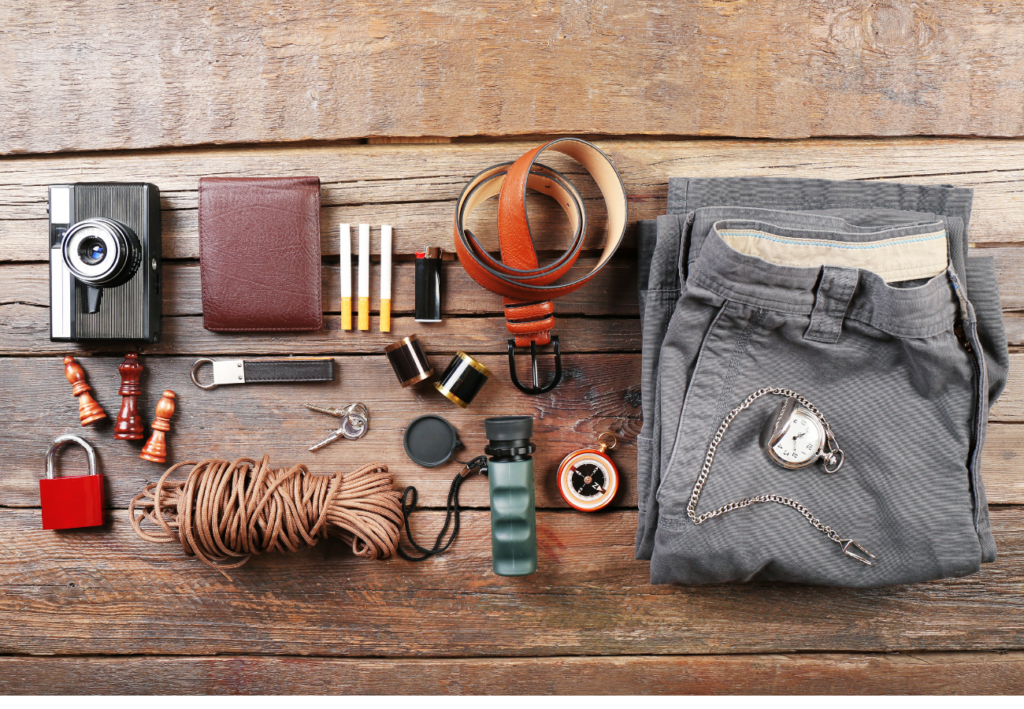Life isn’t cheap. We all know that first-hand. Even budgeting for daily expenses has its challenges, so how are you supposed to earmark money for your passion — on top of everything else? It can often feel like an uphill battle.
But not to worry! In this guest post, hiking enthusiast and veterinary student Taylor has got you covered. She will share some of her most valuable tips to help you save money while finding ways to do what you love.
The best part is that these strategies can offer you more money for your hobbies without earning any more than you make right now! So make sure you read all the way through, as step #7 is the most important one!
Table of Contents
(1) Be conscious of your spending – It’s the best way to manage your money while doing what you love.

You will hear this time and time again because it is SO true. If you don’t know how much you have in the bank, you risk overspending and putting yourself in an unfavorable financial position — without even knowing it.
The path to behavioral change starts with awareness. So if you are not familiar with your financial status, now’s the time to take a good hard look! This is the foundation for financial decisions you will make when it comes to balancing a daily budget and knowing how much you can allocate to fun things like passion projects or hobbies!
Now is also the perfect opportunity to mention that some budgets are more limiting than others. And if you can’t afford “the ideal” items you want. Then make do with what you have!
It is more important to get out there and do what you love than it is to have a single perfect piece of equipment.
For instance, you can save forever for that perfect paintbrush, but you are NEVER going to make art without a brush of some kind. In other words, something is better than nothing to get you started!
(2) Make your equipment last longer.

The longevity of your gear is so important for daily life and in the pursuit of doing what you love! Plus, longer-lasting equipment reduces the frequency of purchases and therefore reduces expenditures.
Tip: Use objects until they are no longer functional instead of no longer pretty.
When older items look a little beaten and bruised, the desire to upgrade is completely normal. But that doesn’t make it completely rational.
Replacing that make-up brush with scuffs on the handle or that camera strap that got some paint on it could be done, but should it?
The best question to ask yourself before purchasing a replacement is: “Is this item still performing?” If it is, then maybe your money could be best spent elsewhere (or put into your savings!)

(3) Buy things second-hand and still do what you love!

Before you head out into the world and purchase something sparkly and new, consider looking for gently used (and less expensive) alternatives. Buying second-hand items = more savings for you + reduces the environmental impact by preventing that item from going to the landfill.
It also creates less demand for production. (Never underestimate your purchasing power!) One person’s trash is another person’s treasure, so you might as well enjoy the discounted price!
The downside of second-hand shopping is that it can be hit-or-miss. Sometimes what you are searching for is just not available, or if it is, you’re just not looking in the right spot.
Tip: Checking online first is usually easiest.
There are a lot of used marketplaces online, including Facebook Marketplace and Kijiji (although others do exist). If you can’t find what you’re looking for, check out the local second-hand shops! Some common shops include Value Village (Canada & United States) and MCC (Canada). Still, you can easily search online for other local shops.
(4) Search the sales!

At this point, you’ve already assessed whether or not you need to make a purchase and decided it’s necessary. And you’ve looked for used items but still came up empty-handed.
Now what?
Well, it’s sale searching time!
Tip: Find the brands that are selling what you’re looking for and subscribe to their email list.
If you don’t need this object right away, then you have time to wait for a sale. In addition, some industries have online third-party sales services that sell items at a discounted price, and these are definitely worth checking out!
Searching for sales is most important for those high-ticket items or when used products are not a great idea. You want to make sure you are saving as much money on large purchases as possible, and sales are the best way to do that!
(5) Determine quality vs. quantity products, and narrow down the best fit for what you intend to buy.

The age-old question of quality vs. quantity is not going away. But, you may apply different standards to different equipment.
It’s a good idea to keep in mind the general trade-offs for yourself, the environment, and your wallet (see the table below).
| Trade-offs | You | Environment | Wallet |
| Quality | Better product, replaced less frequently, and less time without a functional product | Better for environment | More $$$ to do what you love |
| Quantity | Less ideal product, replaced more frequently, and more time without a functional product | Less ideal for the environment | Less $$$ to do what you love |
That does not mean that quantity isn’t the best option in some cases. Occasionally, the perceived quality difference is negligible in practice, and you might not notice the difference.
On top of that, some less expensive items can last nearly as long as “quality” items. However, suppose you are replacing a “quantity” item all the time. In that case, you may end up spending more money than investing in a single “quantity” item.
Make a mental (or actual) note each time you replace an item to ensure you aren’t putting unnecessary time and money into a “quantity” product.
Tip: Branding and specification details (A.K.A. the criteria on which we base our decision) for a product can sometimes lead us to believe that a product is more quality than others.
That may often be the case, but there are exceptions. Try to approach the decision with an open mind! For instance, if a “quantity” item has a lower price tag but lots of testimonials saying how wonderful the product worked for others. Then it may be just as good as the “quality” item you were eyeing up, despite the lower price tag.
Tip: If you are on the fence, try the cheaper one to get a feel for it.
Maybe it works perfectly! If not, you can upgrade when you can, but at least you have something to get you out there and doing what you love.
Tip: Ask yourself: “What would be more troubling for me: (Option 1) spending more money? Or (Option 2) replacing the item more frequently (and potentially going without it until replaced)?”
If you NEED that object (see #7 below), then going without it isn’t a great option, and taking the time to save enough for a quality item is worth it. But, on the other hand, if that price point isn’t feasible, go with Option 2. And don’t worry because you’ll figure things out!
(6) Avoid the domino effect of off-budget spending.

Occasionally, things come up, and we spend money we didn’t plan on parting with. That is normal, and you should let yourself off the hook for unintentional spending because it will happen from time to time.
However, the problem is that it can create a domino effect. Spending unplanned money when you are working so hard to stick to a budget can cause you to think, “Well, I already broke the rule, so who cares… might as well do it again”.
So, when another opportunity to spend money comes up, you are already primed to spend more impulsively.
Tip: The goal is to find a balance (as for most things in life)! Don’t be too hard on yourself, but don’t make it too easy for yourself either!
The moment your spending goes off-track, think about what you will trade for that item. Meaning, if you buy a $5 coffee today, where will you find it in the budget? Are you going to subtract $5 from groceries, gas, etc.? Better yet, think about it before you make your purchase. If you don’t believe that coffee is worth the money, then save it!
(7) Decipher between what you need and what you need right now.

→ This is the most crucial step!
It’s funny how often we replace the word “want” with the word “need.” Oftentimes, what we say we “need” is actually what we think we want.
It is almost like we consider anything that is one step closer to the ideal to be what we need, and sometimes it can be hard to tell the difference.
Tip: When replacing old or used items, throw out the old item before buying a new one.
This approach works wonderfully for disposable products or long-lived items. The reason it works so well is that it shows you whether or not that product has value.
Once the item is gone, it begs the question: do you even notice the loss? If you do, then replace it!
If it fades away with only the occasional thought, then it may not be that important right now. Remember, if you need it later on, you can always re-evaluate down the line. If you don’t immediately miss it, there is no urgency to make a decision.
For example, if you run an online blog and you throw away your old laptop, you ARE going to notice that, right? However, if your laptop breaks down, but your true passion is rock climbing, maybe your phone is sufficient for online use.
Sure having the laptop would be nice. But investing in some new ropes might be the better choice for doing what you love.
Reminder/Tip: Everything is about trade-offs and sacrifice.
If you choose not to invest money in something, there is usually some loss, even if it’s only minor. So the best way to challenge the idea of buying something new is to inventory other expenses you see coming your way. In other words, where would your money be put to best use?
Tip: Only buy one important item at a time.
As appealing as it can be to do all of your shopping at once and get it out of the way in one go, shopping in this manner makes it more difficult to control spending.
If you are on a budget, then spending all of your money at one time is already a no-no (unless you were saving specifically for that day). However, even if you aren’t on a budget, spending a lot of money at one time can make impulse buys seem like less of a big deal.
Why? Because your brain says, “Since I’m already spending so much, this little extra won’t make much of a difference overall.”
The problem is that the bulk amount minimizes the cost of individual items and can lead to post-purchase regret.
One caveat to this would be if they offer insurance. If you are buying expensive equipment, it may come with insurance. This is one “impulse buy” that is worth it — because if something goes wrong with that investment, you have the security of knowing your money isn’t going down the drain.
—
To Sum It All Up
These tips may sound like a lot.
But once you start applying them, you’ll realize they all sum up to one thing: prioritization.
Income is limited. So knowing what is worth your money will be the best way to make financial decisions in your life.
Of course, no one else will have the same priorities as you. But I hope these valuable tips will help you spend more consciously so that you can continue or even get started doing what you love!

Taylor is a veterinary student who enjoys thru-hiking (long-distance backpacking) and is currently building out her van as a liveable space. Being a veterinarian has always been her dream career (and it continues to be), but spending time outdoors is a necessity in her life. She spends a great deal of time hiking, and her longest journey spanned from Mexico to Canada along the 2650-mile Pacific Crest Trail. Taylor created her blog as a way to share her love for the outdoors, document her struggle to find a balance between a professional and nomadic lifestyle, and provide inspiration for fellow adventure-seekers!
Follow Taylor on Instagram @wildtrajectory or head on over to her blog www.wildtrajectory.com. She loves Pinterest and has curated some fun boards focusing on nomadic ways of life – you can check them out at https://www.pinterest.ca/wildtrajectory/.








These are all great tips! Trying to stay within a budget and buying less things that I want but don’t need are two things that I do to get to travel more.
It’s amazing how fast money can add up when you set your spending boundaries! Of course it’s nice to treat yourself sometimes, but the reward of travel is a treat on it’s own 🙂
Love that weighing what I need right now vs what I like to have, lol…
It can be tricky to tell. I’m definitely guilty of tricking myself into thinking I “need” things sometimes!
I love this! It’s very helpful. Thank you for sharing. 🙂
I’m so glad to hear it had value for you ☺️Thank you for your comment!
I love this! These are all great tips to keep in mind throughout our everyday lives. Thank you for sharing!
Absolutely! Little things add up in the long run! I’m glad you got something from the article ☺️
Over the years I have learned to decipher between what I need and what I want. And I am very careful with my belongings. Thanks for all your advice, they are worth sharing with teens to create awareness of how to wisely manage money.
I’m glad to hear you are so money-conscious! I completely agree with you, teaching skills to teens is so important! At that age, I was far more focused on spending money than saving it.
Love these tips! Thank you for sharing. A mindset shift to manage your finances helps out tremendously!
Yes! It can also be the hardest part, but once it clicks, that’s when the true magic happens!
Great budgeting reminders!
Thank you ☺️ I hope they help!
Its really important to consider quality when making purchases.
For sure! I actually think this can be the most challenging part though, because it is completely out of your hands. Even quality items fall apart at different rates and are better for different uses. The question of quality is something I think about a lot when making purchases, especially larger ones.
Great post. You included important tips. Only buy what you need and set realistic goals and evaluate where you are to place where you’re going. Thank you for sharing. ☺️
Pastor Natalie (ExamineThisMoment)
Letstakeamoment.com
Thank you for your comment! I’m so glad you found it helpful ☺️
Nice! We are using numbers 1, 4, and 7 on your list at home right now. We’ll consider using your other tips as well. Thank you for sharing.
Sounds like you’ve already got a solid foundation! Getting the right mindset and knowing your goals helps so much! Other tips can be added as required (or when possible).
Fantastic tips! I left a really good job about a year ago and am making use of some of these for sure!
You are so cool! I do not think I’ve truly read through something like that before. So nice to discover another person with a few genuine thoughts on this subject. Really.. thanks for starting this up. This site is something that is needed on the internet, someone with a bit of originality!